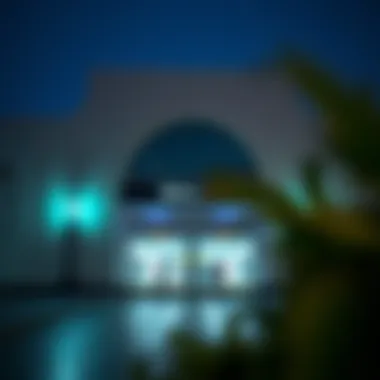Metro Connectivity Insights in Al Quoz, Dubai


Intro
As urban areas burgeon, the importance of robust transportation infrastructure becomes increasingly obvious. Al Quoz is one such dynamic district in Dubai, characterized by its blend of commercial, residential, and industrial spaces. At the heart of this evolving landscape lies the metro system, presenting essential connectivity that shapes daily commutes and economic opportunities. By examining the metro connectivity near Al Quoz, we can glean insightful information about not just transportation options, but also about how these elements influence property investment, local amenities, and future growth prospects.
Understanding the metro network in this area is crucial for several stakeholders, including investors, real estate agents, and potential homeowners. Al Quoz, often seen as an underdog in the spotlight of Dubai’s premium locations, is making strides thanks to its connectivity to Dubai Metro. The ease of access draws businesses and residents alike, enhancing the locality's allure.
In the sections that follow, we will delve into market trends, investment opportunities, and an analysis of how the metro impacts the real estate dynamics of Al Quoz. It's important to remember that metro proximity often equates to increased property value and rental yields, making this exploration vital for informed decision-making.
"In real estate, the mantra 'location, location, location' holds especially true. Proximity to transport hubs can make or break property value."
With that in mind, let’s embark on this detailed exploration of the metro connectivity surrounding Al Quoz.
Preamble to Al Quoz and Its Development
Al Quoz stands as a pivotal junction in Dubai, blending rich history with rapid modernization. Understanding its evolution is essential not just for residents but also for investors and developers eyeing this thriving locale. With metro connectivity playing a crucial role in Al Quoz’s transformation, it shapes how individuals engage with the area, adds vibrancy to community life, and heavily influences real estate strategies.
Historical Context of Al Quoz
Once a mere outpost defined by its sandy stretches and industrial activities, Al Quoz has dramatically transformed over the years. Originally known for its agricultural areas, this neighborhood became a canvas for Dubai's burgeoning art scene, boosted by the establishment of art galleries and studios. The rise of commercial entities also seems to have taken root here. The historical journey of Al Quoz is a tale of transition; evolving from a secluded spot to being enveloped by modern architecture and vibrancy, while still holding onto pockets of its traditional identity.
This shift points out the essence of Al Quoz as a residential and cultural hub. For those exploring investment opportunities, it carries weight in terms of foresightedness. The blend of history with contemporary developments provides a fertile ground for businesses to blossom and for residents to thrive.
Current Growth Trends in Al Quoz
Today, Al Quoz is more than just a blend of old and new. It's a dynamic hotspot experiencing a surge in both residential and commercial property investments. The growth trend is invigorated by various factors, such as the opening of new metro stations and increased foot traffic from art and cultural events. Al Quoz’s strategic location makes it a coveted area, offering easy access to key Dubai districts while maintaining its unique character.
Reports indicate rising property values, signifying strengthened demand. Investors and developers are increasingly recognizing it as an area ripe for long-term investment. Moreover, with the upcoming Metro extensions, the local population is expected to swell, further enhancing its appeal.
In summary, understanding Al Quoz's historical roots and current growth trends is essential for a well-rounded perspective on its potential. As the metro continues to weave its magic in this area, Al Quoz remains a palpable example of how infrastructure development can catalyze urban transformation.
Overview of the Dubai Metro System
The Dubai Metro stands as a remarkable feat of engineering and urban planning, changing the way locals and tourists navigate this dynamic city. In the context of Al Quoz, understanding the metro system is crucial. Not only does it connect different parts of the city seamlessly, but it also shapes how real estate develops in these areas. With its systematic approach to mass transit, the metro encourages sustainable urban growth around its stations, including spots nearby Al Quoz.
History and Evolution of the Metro
The journey of the Dubai Metro reflects Dubai's ambitious approach to modernization. Opening its doors to the public in 2009, the metro aimed at reducing traffic congestion while providing a reliable means of transport. The initial red line stretched about 52 km, marking the commencement of a revolutionary transit system. Over the years, it evolved, expanding both north and south, integrating other lines for comprehensive coverage.
What’s intriguing is how the metro aligns with Dubai's broader vision. Each phase of the expansion is carefully planned to meet the city's growing demands, creating a blend of functionality and design that appeals to a global audience. With an eye toward the future, upcoming phases promise to enhance connectivity and offer even more options for residents and visitors alike.


Key Features of the Dubai Metro
This transport network is not just about getting from point A to B; it’s characterized by several key features that bolster its efficient operation:
- Automated Operation: The metro operates without drivers, enhancing safety and reliability.
- High Frequency: Trains run at regular intervals, minimizing waiting times for passengers.
- Air-Conditioned Coaches: Given Dubai's scorching heat, passengers enjoy a comfortable ride throughout the year.
- Dedicated Tracks: The metro is built on raised structures or underground, ensuring minimal disruption to road traffic.
- Accessibility: Stations are designed with easy access for individuals with disabilities, making it inclusive.
"Efficient public transport is a cornerstone of modern urban living, reducing the burden on existing infrastructure and facilitating growth."
Additionally, the metro networks tie into several other transport modes, further enriching the commuter experience. Buses, taxis, and even cycling paths converge at strategic junctions, amplifying the appeal of Al Quoz and its surroundings for both residents and businesses.
As we delve deeper into the metro's relationship with Al Quoz, its implications for real estate and community life reveal themselves. By fostering an accessible environment, the Dubai Metro isn't just a transportation system; it’s a catalyst for growth and development in this flourishing part of the city.
Metro Stations Serving Al Quoz
The metro stations in and around Al Quoz play a pivotal role in the overall connectivity of this dynamic area in Dubai. These transit points serve as crucial junctions facilitating the movement of residents, workers, and visitors alike. The significance of metro stations cannot be overstated—they not only ease commuting but also contribute to the shifting landscape of real estate development and urban planning in the vicinity. By linking this bustling hub with the rest of the city, the metro promotes accessibility to major business districts and leisure destinations, adding tremendous value to living and investing in Al Quoz.
Al Quoz Metro Station
Al Quoz 1 Metro Station stands out as a key access point for both local residents and businesses. Opened in conjunction with the initial phases of the Dubai Metro, this station has been a lifeline for many who commute daily for work or recreational purposes. Its strategic placement makes it a favorite among those heading towards the city center or other districts.
Facilities around Al Quoz 1 include several retail outlets and eateries, which enhance its functionality as a transit hub. A noteworthy feature is the ample parking space provided, which allows commuters to park their vehicles and switch to the metro with ease. Moreover, because it is part of the Red Line, it allows seamless access to connections to other metro lines, thus broadening commuters' reach to various destinations throughout the city. This connectivity fosters an integrated community environment and has undoubtedly changed the commuting landscape in the area.
Al Quoz Metro Station
Just a stone's throw away from its counterpart, Al Quoz 2 Metro Station amplifies accessibility further, catering specifically to the growing populations and businesses in the Al Quoz area. It's not just a transportation point; it's a bridge linking various facilities that make Al Quoz a more attractive place to live and work.
The station is conveniently placed near several parks and recreational areas, providing residents quick pathways to greenery amidst the urban sprawl. Additionally, the presence of bus links enhances the overall public transportation strategy. This compatibility further encourages a culture of using public transport, which aids in alleviating traffic congestion and enhancing overall environmental conditions. Given that Al Quoz is increasingly becoming a hotbed for cultural and artistic endeavors, having easy access to transportation is essential for artists, students, and professionals who need to traverse the city frequently.
Expo Metro Station - Proximity Considerations
Although primarily linked to one of the world’s largest events, the Expo 2020, the Expo 2020 Metro Station has lasting importance for the Al Quoz area as well. Even after the event wrapped up, the station functions as a pivotal entry point to the broader Dubai scene. Its exposure during the Expo has catalyzed substantial interest in surrounding real estate.
Strategically located, this station serves as a conduit between Al Quoz and key landmarks, including the Dubai World Trade Centre and various exhibition halls. As visitors continue to flock to these areas long after the Expo's conclusion, the increased foot traffic is an asset for local businesses. The station's design incorporates amenities that not only cater to daily commuters but also offer enriching experiences for tourists. Consequently, long-term implications for property investors should be assessed carefully, as the proximity to such a high-traffic locale invariably has the potential to elevate property values in the immediate vicinity.
In essence, the inclusion of these metro stations serves not merely as points on a map. They embody the infrastructure's critical role in shaping community dynamics, influencing real estate trends, and enhancing the quality of life in Al Quoz. As the area continues to develop, these transportation links will be instrumental in its growth trajectory.
Accessibility and Transportation Links
Accessibility and transportation links play a pivotal role in shaping urban environments. In Al Quoz, this aspect is especially salient. Given its strategic location in the heart of Dubai, Al Quoz has seen a surge in residents and businesses flocking to the area. The integration and effectiveness of various transport options, primarily the metro, can influence daily living and economic dynamics for the community, benefiting both individual commuters and businesses alike.
Integration with Other Modes of Transport


The Dubai metro seamlessly connects with several transport options, enhancing the overall accessibility in Al Quoz. When individuals hop off the metro, they aren’t just standing at a station; they’re amidst an extensive network facilitating their journey onward. Buses, taxis, and ride-sharing services complement the metro system, among other means of transport.
- Buses: Several bus routes weave through Al Quoz, providing efficient linkages to surrounding neighborhoods. After a short ride or a brisk walk, residents can catch Bus F30 or Bus F49, making the commute to bustling destinations less cumbersome.
- Taxis and Ride-sharing: You may find taxi stands located near metro stations, where passengers can conveniently hail rides. Applications like Careem and Uber are also popular, ensuring on-demand transport that fits into any schedule.
- Bicycles: In recent times, bicycle lanes have begun popping up around the area, promoting a healthier and more environmentally friendly option for short distances.
This thorough integration ensures that once people arrive at the metro, their journey doesn’t come to a halt. More options lead to less frustration, embedding a sense of convenience into daily commutes.
Impact of the Metro on Commuting Patterns
The advent of the Dubai Metro has undeniably transformed commuting patterns in and around Al Quoz. As commuting habits evolve, the metro's introduction has brought about both expected and unexpected shifts in how people traverse the city.
- Reduction in Traffic Congestion: As residents increasingly opt for the metro rather than personal vehicles, the roads have seen less congestion. This shift isn’t mere chance; many opt for the efficiency the metro brings.
- Time Efficiency: Commuters find that using the metro substantially reduces their travel time compared to traditional methods. Their journeys are no longer bogged down by traffic lights and road blockages.
- Shifts in Working Locations: Businesses and professionals now use the metro to access jobs that may have previously seemed out of reach. This has made Al Quoz an attractive spot for diverse companies, given its improved accessibility.
The metro's presence has catalyzed a shift to a more centralized and efficient urban design. Accessibility breeds opportunity, and Al Quoz’s growth speaks volumes about the synergy of public transport and urban planning.
By understanding how accessibility and transportation links operate in Al Quoz, investors and residents can better appreciate the spatial dynamics of the area. It fosters a well-connected community yet to fully realize the impact that metro connectivity can have on property investment and overall living standards.
Economic Implications of Metro Connectivity
Connecting the dots between metro lines and economic development isn't merely academic; it has tangible impacts on communities, particularly around burgeoning areas like Al Quoz. The expansion of the metro network near this district is not just a transportation upgrade but a significant catalyst for economic growth. This section delves into the multifaceted economic implications brought about by the metro's presence in the area.
Real Estate Opportunities Near Metro Stations
When you think of metro connectivity, envision the bustling activity that springs up around each station. In Al Quoz, the proximity of metro stations means more than just convenience for commuters; it creates an ecosystem ripe for real estate opportunities. Developers eye these areas for commercial and residential projects, knowing that a well-located property can attract both buyers and tenants.
- Commercial Growth: Businesses, from coffee shops to graphic design studios, are keen on locations that see foot traffic. The Al Quoz metro stations can be prime signage spots that draw in customers just by virtue of being near transit.
- Residential Demand: The emergence of new residential projects around metro stations signals a burgeoning two-way market. For homeowners looking to rent, proximity to transit routes increases desirability. Renters gravitate toward metro-accessible housing due to the ease of travel—it’s a factor increasingly shaping urban residential preferences.
Quality of Life and Community Impact
The Quality of Life in Al Quoz is intricately linked to its growing metro connectivity. This enhancement in public transport is far more than simply a matter of convenience; it reverberates through the entire community, fostering a stronger connection among residents and businesses. Understanding this impact can illuminate various aspects, from personal safety to economic prosperity, and reveals why metro access has become a focal point in urban development.
Benefits for Residents and Local Businesses
Access to the metro system provides a wealth of benefits for both residents and local businesses in Al Quoz. For residents, the most apparent advantage is the ability to commute efficiently. Time is money, as they say, and shorter travel times directly translate to more time spent with family, pursuing hobbies, or even just relaxing at home.
For local businesses, metro connectivity means a broader customer base. If a shop can be easily reached via metro, it opens its doors to many more potential clients, drastically increasing foot traffic. The vibrancy of these local businesses can then feed back into the community, fostering growth in employment and bringing new products and services to the area.
- Increased Job Opportunities: With improved connectivity, job seekers can explore options beyond their immediate neighborhoods.
- Lowered Transport Costs: Many residents find metro travel more affordable than overhead costs associated with owning a car, making it easier to allocate funds to other essential areas.
- Community Interaction: With the surge of people in the area, a diverse cultural interaction emerges. It enriches community life, promoting local events and markets that can thrive with more attendees.
Accessibility to Amenities and Services


Metro connectivity is not just about reaching workplaces or shops; it broadens access to crucial amenities and services. Al Quoz is home to a range of facilities, including educational institutions, healthcare services, and recreational spaces. When residents have easy access to these amenities, their overall quality of life improves.
When considering your options, here are a few key aspects impacted by metro accessibility:
- Educational Access: Families can reach schools and universities with ease, benefiting their children's education.
- Healthcare Services: Hospitals and clinics become more reachable, an essential aspect for families who may have special medical needs.
- Leisure Activities: Parks, gyms, and cultural venues become more appealing as commuting to these locations is simplified.
By strategically investing in metro-connected properties, one can find themselves living in a space where the advantage of accessibility translates to a higher quality of life.
"Metro connectivity is more than a convenience; it is a lifeline that connects the heart of Al Quoz with its resources and people."
The symbiotic relationship between metro access and the community's vitality cannot be overlooked. For investors, understanding these dynamics may well prove essential when contemplating future endeavors in Al Quoz's evolving landscape.
Future Developments and Prospects
The topic of future developments around Al Quoz is crucial, especially when considering how metro connectivity plays a role in shaping the area. Understanding these developments allows investors and residents alike to grasp the implications for real estate and community growth. Several elements contribute significantly to the discussion about future extensions, including convenience, economic ramifications, and potential lifestyle improvements.
Upcoming Metro Extensions Near Al Quoz
As urban development continues to accelerate in Dubai, plans for metro extensions are on the radar. The Roads and Transport Authority (RTA) is focused on enhancing connectivity to accommodate the increasing population and commercial activities.
- Route Considerations: Future metro lines may include routes linking Al Quoz to other strategic business areas and entertainment hubs like Dubai Mall and Downtown. This would not only reduce travel times but also increase foot traffic to local businesses.
- Proposed Stations: While specific stations have yet to be finalized, discussions are ongoing. Proposed locations are relevant for both residential and commercial properties, with a focus on accessibility and convenience.
- Integration with Other Transport: Upcoming metro extensions are likely to integrate with other transport systems, such as buses and taxis, making it seamless for commuters to switch modes of transport. This linkage is key to establishing a robust transportation network.
By intertwining the metro with broader transport networks, Al Quoz is set to become a pivotal junction in Dubai’s urban ecosystem. These extensions hold the promise of enhancing convenience for everyone commuting within the city.
Potential Impact on Future Real Estate Trends
The impending expansions in metro connectivity are poised to dramatically influence future real estate trends in Al Quoz. Investors and homeowners should keep a close eye on several aspects that underline real estate dynamics in the area:
- Increased Demand for Properties: With improved access, demand for property in the vicinity of the new stations is predicted to rise. Investors, both local and international, may find fascinating opportunities in acquiring residential or commercial units near these future stations.
- Property Value Growth: As accessibility improves, so will property values. Stakeholders should expect a gradual increase as more people view the area favorably due to its connectivity.
- Shift in Rental Compositions: As the landscape alters, there is likely to be a shift in rental trends. Properties that appeal to commuters could see rising rental prices, making strategic investments more favorable.
The future of Al Quoz’s real estate market is undeniably intertwined with these metro expansions. Understanding the upcoming changes not only helps potential buyers make informed decisions but also assists real estate agents and developers in strategizing for greater success.
Culmination
Understanding the implications of metro connectivity in Al Quoz is crucial for various stakeholders, including investors, real estate agents, homeowners, renters, and developers. This article has elaborated on how essential this connectivity is for enhancing the appeal of the area, impacting commuting patterns, and ultimately influencing property values.
Summary of Key Insights
The integration of Al Quoz into the extended Dubai Metro network offers several key insights:
- Strategic Location: Al Quoz is well-positioned within Dubai, providing easy access to key areas of the city, which is particularly appealing for residents and businesses alike.
- Economic Growth: The metro’s presence has the potential to spur economic growth. Businesses located near metro stations often experience increased foot traffic, which can directly affect their bottom line.
- Real Estate Advantages: Properties near metro stations typically show increased demand and appreciation in value. Investors should consider these locations as prime targets for property purchases.
- Improved Quality of Life: The ease of access to public transport enhances the quality of life for residents, making everyday commutes more convenient, allowing more time for leisure and family activities.
Final Thoughts on Metro Connectivity in Al Quoz
Investors would do well to keep an eye on the evolving landscape surrounding metro stations, as opportunities could arise that speak to future urban trends. The relationship between robust transit systems and local economies is well documented, suggesting that Al Quoz will continue to thrive as connectivity expands.
As the metro network grows, so too does its impact on the urban character of Al Quoz, making it a locale worth watching for anyone interested in Dubai's dynamic real estate market.













